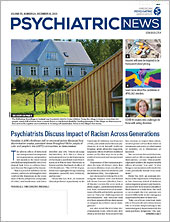The adverse effects of structural and interpersonal racism persist across generations, said panelists last month in the third virtual town hall meeting hosted by APA’s Presidential Task Force to Address Structural Racism Throughout Psychiatry.
“This is a period of turbulence in our country, and we are all being forced to confront the disparities in the treatment of Black, indigenous, and people of color,” said moderator, task force member, and APA Trustee-at-Large Michele Reid, M.D. She is a clinical assistant professor in the Department of Psychiatry and Behavioral Neurosciences at Wayne State University in Detroit and the chief medical officer of CNS Healthcare. The COVID-19 pandemic has highlighted long-standing inequities associated with race, ethnicity, and income, she said.
Chuan-Mei Lee, M.D., an assistant clinical professor in psychiatry at the University of California, San Francisco (UCSF), and a child and adolescent psychiatrist at UCSF Benioff Children’s Hospital, spoke about the long-term, epigenetic effects of adverse childhood events (ACEs) that may occur as the result of structural and interpersonal racism.
“Experiences of discrimination produce the type of chronic stress that increases allostatic load, sets off cortisol production, shortens telomeres, and methlylates DNA,” Lee explained.
Lee discussed screening for ACEs using the Pediatric ACEs and Related Life Events Screener (PEARLS). Part 1 of PEARLS screens for ACEs such as abuse, neglect, and household dysfunction. Part 2 screens for social determinants of health and includes questions such as “Has your child experienced discrimination?” and “Has your child ever been separated from their parent or caregiver due to foster care or immigration?”
Lee also noted the Everyday Discrimination Scale, which asks how often a person has been treated with less courtesy or respect than others, receives poorer service than others in restaurants and stores, is called names or insulted, or is threatened or harassed.
“We can screen for racial discrimination and its effects among kids and their parents,” Lee said. “This acknowledges and validates the negative health effects of racism. It also brings to our attention individuals who could potentially benefit from treatment.”
Ebony Dix, M.D., an assistant professor in the Department of Psychiatry at Yale University School of Medicine and an inpatient geriatric psychiatrist, discussed how structural racism affects Black adults on a daily basis. She cited as an example the ways patients are treated differently in the emergency department because of their race.
“Take an African American male who is 50 years old and a white female who is 50 years old presenting to the same emergency department with the same psychotic symptoms,” Dix said. “I’ve seen time and time again that the full … work-up will be given to the white woman, but for the Black man, the first thing at the top of the differential is substance abuse or schizophrenia.”
Dix also discussed the importance of recognizing diversity within the Black population, particularly as it relates to immigrants.
“We have Black immigrants from the Caribbean, from Africa, from all over the world. We have to make sure that we are not overgeneralizing and [instead] recognize that people who emigrate from other countries have very specific challenges that people who are born in America don’t necessarily encounter,” Dix said.
Peter Ureste, M.D., an assistant clinical professor in the Department of Psychiatry and Behavioral Sciences at UCSF, discussed how structural racism affects Latinx populations. He described how schools were segregated before two landmark cases: Mendez v. Westminster, in which it was ruled that forced segregation of Mexican-American students into separate “Mexican schools” was unconstitutional, and Brown v. Board of Education, in which it was ruled that state laws establishing racial segregation in public schools were unconstitutional.
Ureste explained that the quality of education in “Mexican schools” was below that of White schools, a disparity that still has implications today.
“This is just one of many reasons there are a lot of essential workers within the LatinX community, and … this came into play during the COVID-19 pandemic when a lot of essential workers don’t have the luxury of working at home. They work in the restaurant, food, agricultural, and transportation industries,” he said. “That is one of the reasons there is a higher proportion of people of color who are diagnosed with COVID-19.”
Ureste also discussed how structural inequities disproportionally affect transgender men and women.
“Transgender and gender-nonconforming individuals face extraordinarily high rates of social and health inequalities, including poverty and discrimination by employers. They are [more likely to be] victims of violence, and they face higher rates of family rejection and homelessness than their cisgender peers. I would say this is even more so for transgender people of color,” Ureste said.
At the end of the discussions, Reid gave an update on the task force’s work. Highlights included the following:
•
Three mini-surveys have been conducted to guide the task force’s work and engage APA’s membership. The results are posted at the
APA Presidential Task Force page.
•
The task force’s Assembly work group outlined eight actions to improve diversity and inclusion and reduce structural racism in the Assembly, actions that have since been approved by the Board of Trustees.
•
Feedback sessions have been held with APA councils and committees.
•
Presentations have been made at the Kentucky, Missouri, North Dakota, Ohio, Utah, and Virginia district branches. ■
“The Trauma of Structural Racism and Its Transmission Across Generations” is posted
here. The next town hall will be held Monday, February 8, 2021, from 8 p.m. to 9:30 p.m. ET.
